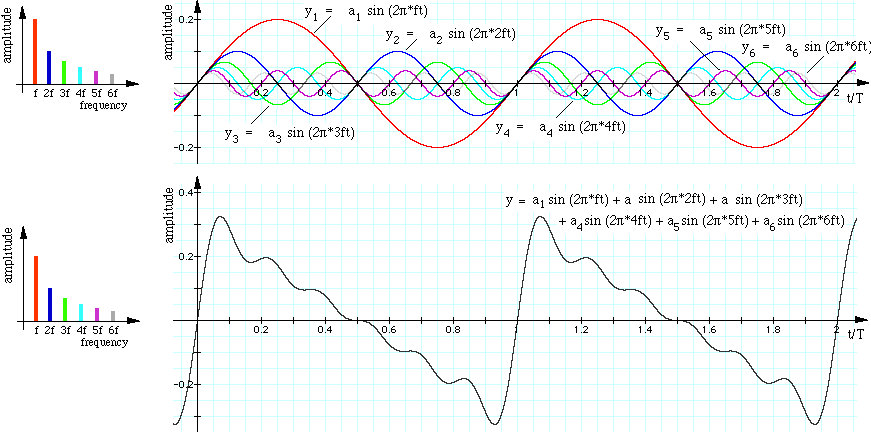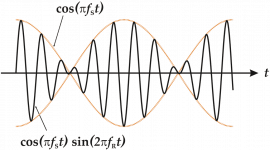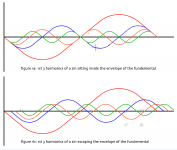It is possible, with training, to detect when the harmonics escape the envelope of the fundemental. A timing thing, not a frequency thing.
dave
So clarify "notes in the air", I think the time of the harmonic will come with a delay to influence the fundamental, but it will come.
I still don't understand what you mean by "when the harmonics escape the envelope of the fundamental". Can you show on the diagram you posted where that is happening?
Those peizo tweeters can have a nasty peak at 17KHz that is 20db above the baseline, I cannot stand any system that uses them, it actually hurts when they hit that resonance!
The envelope isn't created by the fundamental. I think you are confusing what an envelope is. The harmonics shown in the first graph combine to form the waveform in the second, no envelope was harmed in the making of the waveform. 😉
The report on the supertweeter (I have found out the model, it was not the first made by Tannoy, but the second) ST-50, which I could not find, in words available to the inhabitants of planet Earth said something like this:
Do supertweeters matter when we cant hear past 15,000 hz? | Audiogon Discussion Forum
" "Hearing" concerns the conscious notion that we are aware of sound, and the unconscious response to sounds that we may not recognize as such. Our hearing mechanism is mechanical- electrical. Specifically sound activates the mechanical elements of our auditory system which convert mechanical movement to an electrical impulse sent to the brain. Our brain recognizes impulses within a specific bandwidth as "sound", but does not consciously provide a response to impulses outside of the bandwidth range. But- our auditory mechanism responds to sound outside of the normal range of hearing, and our brains still receive an electrical impulse from the out of range stimulus. While we are not conscious of a "sound" generated by out of bandwidth signal, we do acknowledge a response at the subconscious level.
3 landmark studies proved that we can respond to content above 20khz. In the early 1950s the US Army tested the hearing of soldiers and determined that while we can not "hear" content above 20khz, we are aware of it when it is removed from program material. Soldiers reported that something had changed, or was missing from the content, but they could not fully describe what was missing. Just that is was "something". This study and findings were reaffirmed by CalTech in the 90's, and by Swedish researchers about 10yrs ago.
Just about everyone who has reviewed a super tweeter reported that even though they could not "hear" the super tweeter, nor could the pinpoint specific sounds as coming from the super tweeter, felt that it added something beneficial to the overall content. And they definitely could tell when the super tweeter was silent or removed.
Whether or not content above 20khz is important to you, it can be a factor in accurate reproduction of recorded music. Brass and string instruments produce overtones that extend beyond 20khz and can reach up to 40khz. 16/44 digital introduces a brick wall filter at 22khz that abruptly cuts off the harmonics, and causes phase anomalies and odd order distortion to be reflected back into the audible range. How ? Picture a pool of still water, the surface looks like glass. Then drop an object into the center. Ripples will emanate in concentric circles from the point of impact, and flow outward until they come into contact with the wall of the pool. Upon impact with the wall, the ripples are reflected back towards the center, but are out of phase with the ripples still coming from the center. Some of the ripples will cancel each other, some will enhance each other, but the overall effect will be very noticeable.
HiRez digital allows for the filter to be moved out to the point where it no longer interferes with extended instrument harmonics. 24/96 extends it to 48khz, and higher sampling rates move the wall further outside the audible range. Listeners almost universally report that hirez sounds smoother, more natural, and more analogue like compared to 16/44 Red Book.
A long winded answer, but I hope it helps."
This is what I wanted to exemplify with my limited knowledge on a subject as complex as acoustics when I suggested to the OP not to remove the tweeter even though his hearing is reduced at high frequencies.
Maybe Matt can find it since he is Tannoy's neighbor, ..... it would be very useful for everyone.😀
Do supertweeters matter when we cant hear past 15,000 hz? | Audiogon Discussion Forum
" "Hearing" concerns the conscious notion that we are aware of sound, and the unconscious response to sounds that we may not recognize as such. Our hearing mechanism is mechanical- electrical. Specifically sound activates the mechanical elements of our auditory system which convert mechanical movement to an electrical impulse sent to the brain. Our brain recognizes impulses within a specific bandwidth as "sound", but does not consciously provide a response to impulses outside of the bandwidth range. But- our auditory mechanism responds to sound outside of the normal range of hearing, and our brains still receive an electrical impulse from the out of range stimulus. While we are not conscious of a "sound" generated by out of bandwidth signal, we do acknowledge a response at the subconscious level.
3 landmark studies proved that we can respond to content above 20khz. In the early 1950s the US Army tested the hearing of soldiers and determined that while we can not "hear" content above 20khz, we are aware of it when it is removed from program material. Soldiers reported that something had changed, or was missing from the content, but they could not fully describe what was missing. Just that is was "something". This study and findings were reaffirmed by CalTech in the 90's, and by Swedish researchers about 10yrs ago.
Just about everyone who has reviewed a super tweeter reported that even though they could not "hear" the super tweeter, nor could the pinpoint specific sounds as coming from the super tweeter, felt that it added something beneficial to the overall content. And they definitely could tell when the super tweeter was silent or removed.
Whether or not content above 20khz is important to you, it can be a factor in accurate reproduction of recorded music. Brass and string instruments produce overtones that extend beyond 20khz and can reach up to 40khz. 16/44 digital introduces a brick wall filter at 22khz that abruptly cuts off the harmonics, and causes phase anomalies and odd order distortion to be reflected back into the audible range. How ? Picture a pool of still water, the surface looks like glass. Then drop an object into the center. Ripples will emanate in concentric circles from the point of impact, and flow outward until they come into contact with the wall of the pool. Upon impact with the wall, the ripples are reflected back towards the center, but are out of phase with the ripples still coming from the center. Some of the ripples will cancel each other, some will enhance each other, but the overall effect will be very noticeable.
HiRez digital allows for the filter to be moved out to the point where it no longer interferes with extended instrument harmonics. 24/96 extends it to 48khz, and higher sampling rates move the wall further outside the audible range. Listeners almost universally report that hirez sounds smoother, more natural, and more analogue like compared to 16/44 Red Book.
A long winded answer, but I hope it helps."
This is what I wanted to exemplify with my limited knowledge on a subject as complex as acoustics when I suggested to the OP not to remove the tweeter even though his hearing is reduced at high frequencies.
Maybe Matt can find it since he is Tannoy's neighbor, ..... it would be very useful for everyone.😀
Last edited:
@academia50 It is quite possibly a phase issue and extending the system response by an octave could well be advantageous. We are largely stuck with BW limited recordings though.
Last edited:
@academia50 It is quite possibly a phase issue and extending the system response by an octave could well be advantageous. We are largely stuck with BW limited recordings though.
BW = Bandwidth?
Have you read the article I cited? It is generally accepted that supertweeters arose in response to the emergence of higher BW media, (DVDAudio - SACD) which is debatable. But full stop for me, or we'll get off the OP topic ....😉
Yes, bandwidth. I've only read what you posted but have read similar and there was a long discussion about it on the blowtorch thread. The consensus was that a higher BW means a lower order filter can be used which reduces group delay which could explain the listening impressions. Bare in mind a tweeter is a low pass filter and the system response has to be viewed as a whole. Group delay is perceived more at lower frequencies and quite often people say a supertweeter improves the bass timing.
Last edited:
From back in my synth-interest days, an envelope described the time - amplitude modulation of a generated signal. "Attack - Sustain - Decay - Release" terms were used to describe the various timing portions of the envelope. Certain attributes of these, such as "slow" Attack, further described how a musical note sounded, usually in the context of trying to reproduce the sound of a real instrument.
So when Dave said "escape the envelope", I started imagining each harmonic - the 2X, 3X, 4X, 5X stuff each having their own time - amplitude envelopes. Since they were all shown to be lower in amplitude than the fundamental (to make, say, a sawtooth waveshape) this "escape" I imagined to be some point in time where any one of the harmonics was higher in amplitude than the fundamental.
This could be because the fundamental's time envelope was decaying at a faster rate than that of said harmonic. Or perhaps due to some resonance one of the harmonics excited, where it - in the process of reproduction - became higher than - escaped - the envelope of the fundamental. originally recorded as following this envelope profile, ended up with a very different profile on reproduction. (Sounded like sh*t as a result...)
Did this earthling come even close to understanding what was being described? I think the classic single note electric guitar feedback sound is an example - where it starts off at a fundamental, then the 2nd takes over as the fundamental drops away.
So when Dave said "escape the envelope", I started imagining each harmonic - the 2X, 3X, 4X, 5X stuff each having their own time - amplitude envelopes. Since they were all shown to be lower in amplitude than the fundamental (to make, say, a sawtooth waveshape) this "escape" I imagined to be some point in time where any one of the harmonics was higher in amplitude than the fundamental.
This could be because the fundamental's time envelope was decaying at a faster rate than that of said harmonic. Or perhaps due to some resonance one of the harmonics excited, where it - in the process of reproduction - became higher than - escaped - the envelope of the fundamental. originally recorded as following this envelope profile, ended up with a very different profile on reproduction. (Sounded like sh*t as a result...)
Did this earthling come even close to understanding what was being described? I think the classic single note electric guitar feedback sound is an example - where it starts off at a fundamental, then the 2nd takes over as the fundamental drops away.
Last edited:
Follow that by H2O2 (3%, not hair bleach), then a drop or two of olive oil.Don't waste your money on special ear drops.
A drop of extra virgin olive oil applied to the ear is all you need to soften and remove the wax.
Lay on your side and dribble the H2O2 in your ear until the canal is full. rest for a couple of minutes and put a paper towel over your ear. roll over and let it drain.The H2O2 will bubble it right up. afterwards put a drop or two of olive in each ear and let them dry.
From back in my synth-interest days...
I imagine an artificially created signal could have amplitude escape (are there any acoustic instruments with that kind of harmonic progression?).
I was meaning escaping in time… like when the tweeter signal eminates from behind the midBass. I think there are some instruments where that does happen naturally.
If the timing of the harmonics changes so does the waveform that is their sum.
dave
Attachments
From back in my synth-interest days, an envelope described the time - amplitude modulation of a generated signal. "Attack - Sustain - Decay - Release" terms were used to describe the various timing portions of the envelope. Certain attributes of these, such as "slow" Attack, further described how a musical note sounded, usually in the context of trying to reproduce the sound of a real instrument.
Yes, there's no reason different harmonics couldn't have different envelopes. An extreme example would be a cymbal crash with frequencies and transients all over the place. The question is what is our temporal aural acuity? As I posted earlier the threshold appears to be 1ms, it degrades with age, but all the same doesn't equate to particularly high frequencies, and the system needs the bandwidth to render them anyway.
Dave,If the timing of the harmonics changes so does the waveform that is their sum.
The harmonic arrival time changes the sum of the waveforms, but has no effect at all on the ability for one to hear them if the harmonic (or fundamental) is below the SPL required for hearing.
For instance, I can hear 2000 Hz at "normal" level, but due to NIHL (noise induced hearing loss) the second harmonic of 4kHz must be 36dB louder than the fundamental for me to detect it.
Presbycusis (age-related hearing loss) and NIHL requires the third harmonic (8kHz), 18dB louder, and the fourth, (16kHz) forget about it- tweeters (and the 63 year old "girlfriend") couldn't handle a 90dB boost..
Those results are with headphones, but to give you an idea of what hearing loss is like, a few days ago while testing my hearing using loudspeakers 2 feet (60cm) from my ears, Bonnie, in another room, around a corner, at least 20 feet (6 meters) away, yelled "Oww, turn that down!" before I could even hear 4kHz.
I have been very careful to not expose my hearing to loud noise (or music) for the last decade, yet presbycusis has reduced my high frequency hearing a lot just over the last 3 years.
I have been researching hearing aids again for the last several days, advances in frequency lowering, AKA "frequency compression" may be able to restore the lost harmonics and fricatives for me, will be auditioning some soon.
Art
Attachments
That's interesting, let us know how you get on. Have you tried modern hearing aids? The only ones I've heard had a noticeable delay in the boosted frequency range resulting in awful distortion for music, still helped with speech though which is what they're designed for after all. The audiologist said most people don't notice it which I don't believe.I have been researching hearing aids again for the last several days, advances in frequency lowering, AKA "frequency compression" may be able to restore the lost harmonics and fricatives for me, will be auditioning some soon.
Dave,
I have been researching hearing aids again for the last several days, advances in frequency lowering, AKA "frequency compression" may be able to restore the lost harmonics and fricatives for me, will be auditioning some soon.
Art
Your experience tracks with mine. I've worn hearing aids for 8 years now, my loss is a combination of exposure related, age related (68) and a moderate case of Meniere's syndrome. The newer hearing aids are greatly improved, particularly in the area of feedback suppression.
For most of us this is too late but some work has been done using the antioxidant NAC before sound exposure. It's supposed to block the damage caused by loud sound levels.
...4kHz must be 36dB louder ...
That is a seriously odd curve. And confirmed by Bonnie's complaint. You have NO loss except in a part-octave? Have you spent years around a whistle? (My loss may track the wind-noise of my cars...) Sleigh-bells?
- Home
- Member Areas
- The Lounge
- Hearing loss



